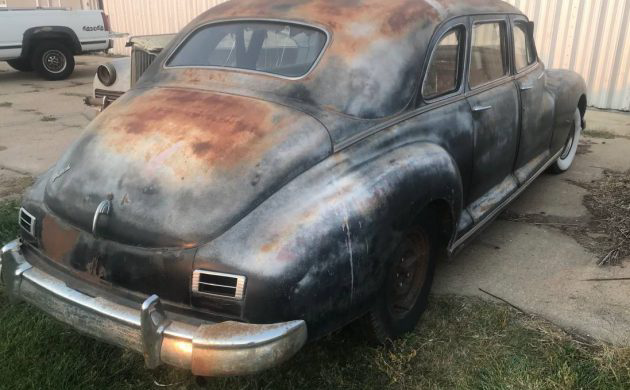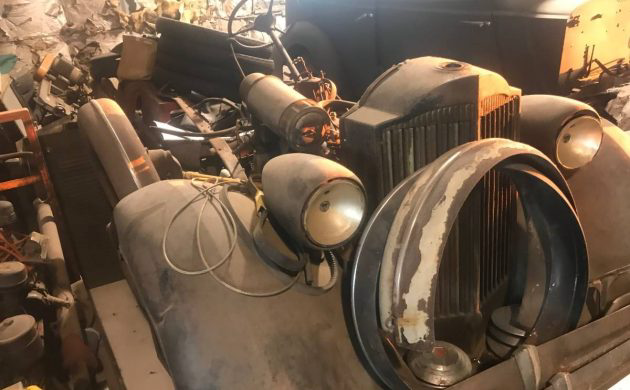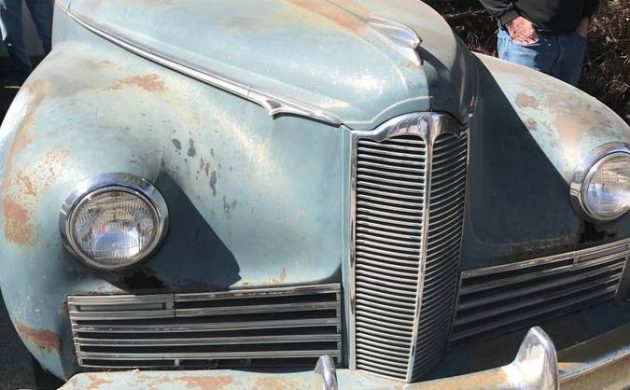Huge Packard Collection for Sale!
An assortment of Packard cars and parts, which have been accumulated since the middle 1960s, are available as a package deal in Omaha, Nebraska. The collection seems focused largely on Series 8 and Clipper models. There are ten vehicles in this package deal! Some have been stored inside and some outside. Everything is available here on craigslist for a flat price of $40,000. There is no mention if the collection would be parted out. Ikey H, you may have outdone yourself this time sending this tip our way!
Packard Motor Car Co. began building automobiles in 1899 and the emphasis was always on luxury with a pinch of performance. The end of the road for the brand would come in 1958 after the unsuccessful acquisition of Studebaker didn’t pan out. In fact, the Studebaker brand would outlive the Packard name for another eight years. Two of the storied Packard models were the Series 8 and the Clipper, the target of this collector’s attention for 55 years.
Series 8
The Packard Eight was a luxury car built between 1930 and 1936 and was a progression from the earlier Packard Six. It was offered in four models, the Standard Eight, Custom Eight, Deluxe Eight, and the Speedster. The Eight was available on several wheelbases, from 127.5 inches to 145.5 inches. The cars were packaged as two-door roadsters, two-door convertibles, phaetons, two-door coupés, four-door sedans, landaus, town cars, and limousines. These were big, beautiful cars built for those with well-defined tastes in automobiles and deep pockets.
Clipper
The Packard Clipper was a departure from the company’s more opulent cars, perhaps touching Mercury buyers instead of Continental. They were built in sporadic runs for 1941–42, 1946–47 and 1953–57. For 1956 only, Clipper was a stand-alone marque. About the time that Packard and Studebaker pooled their resources, it was decided that the Clipper was diluting Packard’s image and the nameplate was dropped. The Packard emblem itself would disappear on production cars just a couple of years later.
The Collection
Interpreting the seller’s ad, it looks as though a Packard enthusiast started collecting these cars in 1965 and perhaps some have come, and some have gone, over the years. What’s here are 10 vehicles, seven of which are said to be complete and the other three are parts cars. Sedans, limos and convertibles in various trim levels across the Series 8 and Clipper are here for the taking. We’re told a few of the cars will run in their current state, but they are largely project cars needing further work. Besides the autos, the collector created a stash of refinished parts, chrome and stainless bits, some rare pieces and several motors, although none are the coveted V-12s.
To me, this has the earmarks of a collection being liquidated because the person behind it all has passed away and the heirs want to be done with it. Otherwise, it would be more effective to sell this off a car, engine or part at a time, perhaps for more overall dollars. But it will take another Packard aficionado to come along and take it all for 40 grand.
Auctions Ending Soon
 2002 Subaru Impreza WRXBid Now2 days$333
2002 Subaru Impreza WRXBid Now2 days$333
 1975 Chevrolet Corvette ConvertibleBid Now2 days$4,000
1975 Chevrolet Corvette ConvertibleBid Now2 days$4,000
 1964 Ford F-100 Camper CustomBid Now2 days$2,000
1964 Ford F-100 Camper CustomBid Now2 days$2,000
 2006 Jeep Wrangler SportBid Now4 days$10,500
2006 Jeep Wrangler SportBid Now4 days$10,500
 1974 Datsun 260ZBid Now6 days$460
1974 Datsun 260ZBid Now6 days$460







Comments
Lot of nice stuff, but Russ’ last paragraph echoes through out the land,,”owner passed, and the heirs want to be done with it”. Can’t blame them, really, fewer and fewer are interested in something like this. I don’t think the price is seriously out of line, there are some very rare parts, and I think there are still enough Packard fans, someone will pick this stuff up, but situations like this should be a clear sign, the end is near,,,for collections like this, anyway.
It’s it a sign of anything.
Even though the Packard make has a following. That doesn’t mean every one of their models has one. Most models within any specific make have little to no appeal beyond being old and surviving, for them, condition should be the only thing that matters since they generally have no appeal based on their own merit. This is nothing new, it’s just a moving target on a calendar and always has been. Makes and models that had a strong following will continue to have a following, their prices will reflect that. The interest for desirable older cars, especially performance models is not going away, it never will on it’s own.
Cars that people dreamed of owning when they were young will continue to be popular, those that weren’t, won’t be.
Steve R
It seems like Hemmings would be the best place to advertise a collection like this, not CL.
There is a Packard Car Club that should know about this as well as ads in Hemmings and other publications.Henry Ettling in Southern Ohio had tons of
Packard parts and it may still be stored by his widow even after 22 years.
One thing for sure is that none of these parts will be reproduced and few of the last 2 generations have any idea of what Packard was and its contribution to the winning of WW2.Tons of these parts for Packard and others have been recycled into washers and dryers and Mickey Mouse cars that in no way reflect their origins.
The last two generations have almost no idea of what WWII was, let alone the role that Packard had.
MANY Packard parts have been reproduced over the last 40 years, and many pieces continue to be available as quality reproductions.
Born in 1954, and I didn’t know that Packard built the Merlin engines! Thanks for the reference all!
Packard built Merlin engines , but it was a Rolls Royce engine. Packard built them under licence to increase production .
Packard also had a great reputation for large V12 marine engines. Their ability to manufacture high quality V12 PT and air rescue service marine engines as well as the American series of Rolls Royce Merlin engines were a major contribution to WWII Allied success. Packard made many improvements to the Merlin as they developed their series of engines. Additionally Packard’s ability to turn out large numbers of Merlins resulted in a series of British Spitfires and Canadian Mosquito aircraft solely powered by Packards.
In the early days of automotive development there were discussions about engines.Some liked a 4 cylinder,some said a 6 cylinder and Packard was making one but their master engineer Jesse Vincent dropped a V12 on the market called the Twin Six that created quite a furor and it was made until 1923.It was again revived in 1932 as the Packard 12 and a fine engine it was.They were also making an inline 8 but the really powerful inline 8’s
were the Model “J” Duesenbergs that no flat head engine could match.
This experience with V12’s certainly gave Packard an advantage when Rolls Royce needed all the aircraft engines they could get and Col.Vincent once again delivered what was needed.
After the war Packard finally finished their own design for an automatic transmission that began in 1934 but as time went on this transmission was a problem and after the powerful V8’s of 1955 and 56 they became a liability that was a major contributor to the downfall of the Detroit Packard Motor Car
along with their torsion bar suspension with leveler that was straight out of Rube Goldberg’s book of screwball ideas
Bob Roller,
I’ve owned over 300 Packards over the last 50+ years, and I must correct you concerning the V8 Packards of ’55 & ’56. The Torsion bar suspension was an incredible design, and provided a smoothness of ride that NONE of the competition could duplicate. As good as the Citroen hydro-pneumatic system was, the Packard torsion level ride was superior, especially when running over a very rough road.
Yes, the Twin-Ultramatic transmission could be troublesome if abused, but had the company been able to keep going for a few more years, they would have solved the problems. [Packard Club members did work out the problems without factory help – it was gone after 1956.]
The torsion level system was released before the bugs were out of it.and I saw more than one Packard on the streets with the rear end up in the air because the leveler motor failed to drag the car back to level.As far as the Ultramatic is concerned it was another failed idea.Lincoln bought Hydramatics from GM with no loss of sales or prestige.
I had a 1955 Patrician and it was a real pain.A magnificent engine and nothing else to go with it.A local business man
was told he had to take the Ultramatic because standard
shift was not available.He also had no need for the torsion bars either.He went to a dealer in Kentucky and bought a new 1955 Packard off the showroom floor with standard transmission and no torsion bars or electric load leveler
and ke kept it for 30 years and by then the Ultramatics and the load levelers were in the junkyard where they belonged.
Now about the collection;
While the collection is likely worth more than the asking price when sold by the piece or car, there are VERY FEW people willing to buy a collection of this size, unless the price is VERY cheap. Selling old car parts in bulk or wholesale, means a sharply reduced price for many reasons. First of all is what it will take to transport everything to the new owner’s location. Then it comes time to inventory all the cars, so the correct parts get assigned to the right cars. The bigger situation is the ability of the buyer to store 10 cars inside, and the room to store & inventory the parts.
Plus there is the work of inventorying all the extra parts. In 1978 I bought the entire inventory of a NAPA parts store that closed in 1970. It was on the market for a long time before I finally bought it for $1,200 after I explained why it was not selling for more money. I was still selling parts from that inventory 25 years later, all the while having to store the parts.
When I was still buying Packard parts and collections like this selection, I would always explain to the sellers exactly why I was going to offer a significantly lower price. Most of them, when they understood what was involved, accepted my offer. [I bought my first Packard dealership inventory in 1973, at a time when old Packard parts inventories were often sent to the junkyard as scrap. Paid the very fair asking price of $125 for it all!]
Yes, Bill, your story reminds me of the several years I spent in the Volvo 1800 parts “business”. By the time I found the junk cars, transported them to my shop, disassembled them, cleaned/photographed/advertised/shipped the parts, and finally disposed of the rusted carcasses, there was an assload of work involved. And plenty of fees and taxes too.
I used to joke that I was in the business of giving away old Volvo parts….just pay me for my time doing all of the above, and the part is free.
So Bill, is the Packard community on the wane some 65 years after the company’s demise, or is there still a strong contingent of Packard enthusiasts out there? Just curious.
Rex Kahrs.
In general, the Packard community is not on the wane, the club is still very active, just look at it’s website! Because Packards were still being actively driven well into the 1960s, many former dealer’s shops remained busy repairing them, and there were still a lot of dealer stocks of parts around in the early 1970s when I began buying them up cheap.
And having owned a restoration shop that restored 4 Volvo 1800s, I probably bought parts from you!
WHY in the H*ll do people take on 3-4 projects at a time and THEN never finish just one??
Are they gluttons or sompin?
IMHO, just do one…maybe two if ya job some of it out, but 3-5?
Then, the poor guy dies and his heirs junk everything.
Just a shame to see this kind of thing.
Lots of hungry car guys going without these days, going hungry I say.
I let go of a classic 1971 Road Ranger camper project today, cuz I’m never gonna get to it ANYTIME soon.
I GAVE it away to a friend who was BURNED out in the recent California fires.
He escaped in the middle of the night with the clothes on his back and one dog.
He has been staying with friends.
It felt GOOD to help him out. I’ll be helping him rebuild with some of my equipment and supplies.
He will pay NOTHING for my help.
Great post, and I’ve often wondered that too, why so many projects and none get finished. Today, just completing one is out of the question, but it probably wasn’t so when this person began collecting. I know how it is, something came along, in this case Packard stuff, CHEAP, and you can’t refuse. Before you know it, you have a slew of vehicles, some that never were intended to be finished, like I say, I bought TWO, 4 doors Packards, that didn’t look any different than the ’47 Clipper, for $300 bucks, just to get the visor on one. I didn’t use much else, but they were there for any parts. One had an extra automatic someone cobbled in one. Today, THOSE parts cars are what people today, if any, are restoring, because there is nothing else. Tip of the iceberg here, we’ll see a lot more of this.
Thanks for helping someone out, shows there’s still hope.
Wasn’t there an attempt to revive the Packard as a V12 luxury car with a Falconer?V12 engine?We have nothing to meet these German Maybach head on in the market.The 4 and 6 cylinder Lincolns certainly won’t and Cadillic has become a Chevrolet in evening clothes.
Looks like there are at least 4 full classics, or parts of them, included in this lot, according to the standards of the Antique Automobile Club of America.
Hoarding vs Collecting often develops as one ages out of doing work for a hobby. It is essential to pass it on to others for what you have in it and one should not hoard for profit later. Time is closing on all Packards. A prior post said cars are restored as drivers if one has a connection of memory to the vehicle. This is it for the club and meets and sales.
If I had the money to spare & the place to put them, hell yes, I’d snatch up this cache of Packard goodness without a blink!
Love to talk to Mr. Bob Roller. I own a 1956 Packard Pactrician. Sure could use some advice, please. Tom 209 601 0270